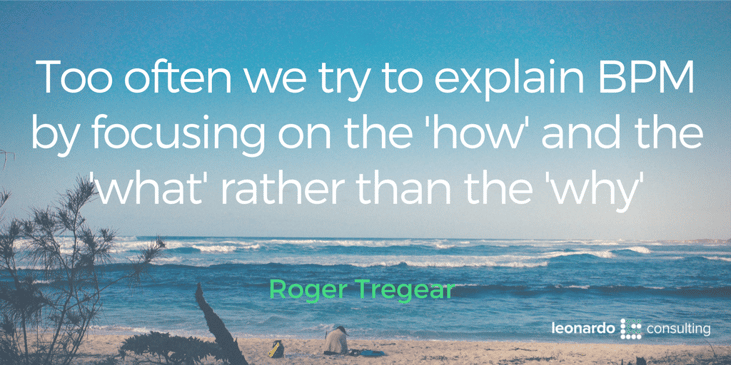 If we are evangelists for BPM, if we are advocates for the power of process, what is it that we believe? What are the essential elements of process-based management that we hold to be compelling?
If we are evangelists for BPM, if we are advocates for the power of process, what is it that we believe? What are the essential elements of process-based management that we hold to be compelling?
These are not new questions. I have previously written in this blog about the critical need for organizations to determine and document the compelling reasons that are powering their particular BPM journey. These provide the bedrock necessary to sustain commitment during what will inevitably be occasionally difficult times along the way.
For those of us for whom the process view resonates powerfully, we hold these truths to be self-evident. The reality is that for many people, this is simply not true. In their book Made To Stick1, Chip and Dan Heath describe the curse of knowledge as follows:
“Once we know something, we find it hard to imagine what it was like not to know it. Our knowledge has “cursed” us. And it becomes difficult for us to share our knowledge with others, because we can’t readily re-create the listeners’ state of mind.”
I have recently read “Start With Why2” by Simon Sinek. The idea is simple but powerful. “People don’t buy what you do, they buy why you do it.”
Read the book to understand the details of the Why/How/What insights. Suffice to say here that Dr Martin Luther King Jr changed a nation, and the world, by saying “I have a dream”, not “I have a detailed plan and methodology with accompanying PowerPoint”. The detailed plans, the How and the What, were important, but they were not the starting point. They were not what ignited a shared commitment to powerful and long lasting change.
Perhaps too often we try to explain BPM and process-based management by focusing on the How and the What. Simon Sinek and Dr King would advise us to start with Why. Why does the idea of BPM exist? What is its purpose? Modeling, process architectures, improvement methodologies etc are about what we do and how we do it. But why should anyone want to do those things?
Important initiatives like Roger Burlton’s BPM Manifesto and the Process Knowledge Initiative give useful insight for How and What. If people buy, not what we do but why we do it, what is the belief set that gives the Why to BPM?
The BPM Creed
Here is my suggestion for a statement of why, as process professionals, we believe.
We believe in ...
- unimpeded flow of measurable value between our organization and its customers and other stakeholders
- uncovering and eliminating wasteful activities
- a workplace that enables our staff to deliver value
- eliminating frustration caused by broken processes
- having more certain control over things that really matter
- technology supporting business processes, not the reverse
- continuous improvement and discontinuous innovation.
Let’s tease those out a little more.
Flowing Value
We want unimpeded value flowing between customers, the organization and other stakeholders. It’s a multi-path flow. Not just inside-out or outside-in, but appropriate, measurable and managed value flowing amongst participants. We believe in delivering and receiving value.
Eliminating Waste
In every organization there are many circumstances where time, money and goodwill are wasted. It feels like we are driving with the brakes on, that there is sand in the gears. Waste causes transmission loses in the value flow. We believe in good old fashioned thrift when it comes to value flow.
Enabling Staff
People turn up intending to do a good day’s work. Sometimes our processes disable their good intentions resulting in more value losses and demoralized staff. We believe in our people.
Eliminating Frustration
Have you been inconvenienced recently by another organization’s broken processes? Most of us have. Your customers have probably been frustrated some of your processes as well. Rough edges cause disruption and losses in the flow of value. We believe in creating smooth transactions for our customers.
Achieving Control
What really matters is our ability to optimize the exchange of value amongst customers and stakeholders. This is what we need to understand and track. Everything else is secondary. We believe in thoughtful control of value delivery.
Supporting with Technology
Optimized processes are central to value delivery. Appropriate use of technology is a key element of many, but not all, process improvements. The process view is dominant; automation is but one option for process improvement. We believe in the automation of process execution where that improves delivered value.
Continuously Improving
Most processes can be improved. In a process-centric culture it is everyone’s job, and aspiration, to make frequent process improvement. Process improvement should a habit, not just a project.
We believe in continuously increasing the value we deliver.
Discontinuously Innovating
Continuous improvement has a natural limit. A single process, continuously improved, ultimately reaches a point where there is no cost-benefit in further improvements. A step function change is then required to facilitate first one-off, and then continuous, improvement. We believe in pushing the limits of value delivery.
In Summary
As process professionals we believe in continuous small, and occasional large, improvements in the unimpeded exchange of value with minimal transmission losses from waste and broken processes, in empowering customers and staff to gain maximum value from their interactions, supporting such exchanges with appropriate technology and consciously focusing measurement and management on value delivery.
Do you agree that this is why process professionals believe? Is this the Why of BPM?
1 Chip & Dan Heath. Made To Stick. Random House, London, 2007.
2 Simon Sinek. Start With Why: How Great Leaders Inspire Everyone to Take Action. Portfolio, New York, 2009.




